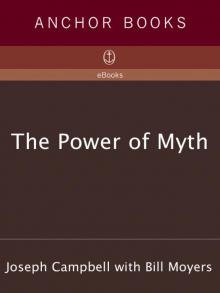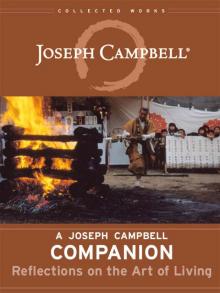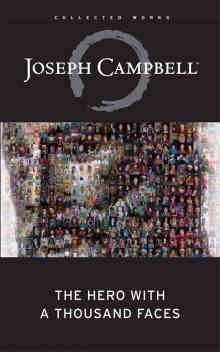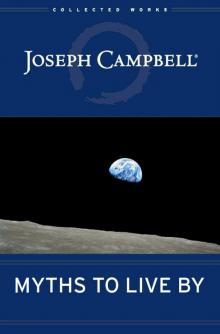- Home
- Joseph Campbell
The Hero with a Thousand Faces Page 2
The Hero with a Thousand Faces Read online
Page 2
Perhaps it will be objected that in bringing out the correspondences I have overlooked the differences between the various Oriental and Occidental, modern, ancient, and primitive traditions. The same objection might be brought, however, against any textbook or chart of anatomy, where the physiological variations of race are disregarded in the interest of a basic general understanding of the human physique. There are of course differences between the numerous mythologies and religions of mankind, but this is a book about the similarities; and once these are understood the differences will be found to be much less great than is popularly (and politically) supposed. My hope is that a comparative elucidation may contribute to the perhaps not-quite-desperate cause of those forces that are working in the present world for unification, not in the name of some ecclesiastical or political empire, but in the sense of human mutual understanding. As we are told in the Vedas: “Truth is one, the sages speak of it by many names.”[2]
For help in the long task of bringing my materials into readable form, I wish to thank Mr. Henry Morton Robinson, whose advice greatly assisted me in the first and final stages of the work, Mrs. Peter Geiger, Mrs. Margaret Wing, and Mrs. Helen McMaster, who went over the manuscripts many times and offered invaluable suggestions, and my wife, who has worked with me from first to last, listening, reading, and revising.
Joseph Campbell
New York City
June 10, 1948
* * *
Endnotes
[1] Sigmund Freud, The Future of an Illusion (translated by James Strachey et al., Standard Edition, XXI; London: Hogarth Press, 1961), pp. 44–45. (Orig. 1927.)
[2] Ṛg Veda: 1.164.46.
Figure 1. Medusa (carved marble, Roman, Italy, date uncertain)
PROLOGUE
The Monomyth
1. Myth and Dream
Whether we listen with aloof amusement to the dreamlike mumbo jumbo of some red-eyed witch doctor of the Congo, or read with cultivated rapture thin translations from the sonnets of the mystic Lao-tse; now and again crack the hard nutshell of an argument of Aquinas, or catch suddenly the shining meaning of a bizarre Eskimo fairy tale: it will always be the one, shape-shifting yet marvelously constant story that we find, together with a challengingly persistent suggestion of more remaining to be experienced than will ever be known or told.
Throughout the inhabited world, in all times and under every circumstance, myths of man have flourished; and they have been the living inspiration of whatever else may have appeared out of the activities of the human body and mind. It would not be too much to say that myth is the secret opening through which the inexhaustible energies of the cosmos pour into the human cultural manifestation. Religions, philosophies, arts, the social forms of primitive and historic man, prime discoveries in science and technology, the very dreams that blister sleep, boil up from the basic, magic ring of myth.
The wonder is that characteristic efficacy to touch and inspire deep creative centers dwells in the smallest nursery fairy tale — as the flavor of the ocean is contained in a droplet or the whole mystery of life within the egg of a flea. For the symbols of mythology are not manufactured; they cannot be ordered, invented, or permanently suppressed. They are spontaneous productions of the psyche, and each bears within it, undamaged, the germ power of its source.
Figure 2.Viṣṇu Dreaming the Universe (carved stone, India, c. a.d. 400–700)
What is the secret of the timeless vision? From what profundity of the mind does it derive? Why is mythology everywhere the same, beneath its varieties of costume? And what does it teach?
Today many scientists are contributing to the analysis of the riddle. Archeologists are probing the ruins of Iraq, Honan, Crete, and Yucatan. Ethnologists are questioning the Ostiaks of the river Ob, the Boobies of Fernando Po. A generation of orientalists has recently thrown open to us the sacred writings of the East, as well as the pre-Hebrew sources of our own Holy Writ. And meanwhile another host of scholars, pressing researches begun last century in the field of folk psychology, has been seeking to establish the psychological bases of language, myth, religion, art development, and moral codes.
Most remarkable of all, however, are the revelations that have emerged from the mental clinic. The bold and truly epoch-making writings of the psychoanalysts are indispensable to the student of mythology; for, whatever may be thought of the detailed and sometimes contradictory interpretations of specific cases and problems, Freud, Jung, and their followers have demonstrated irrefutably that the logic, the heroes, and the deeds of myth survive into modern times. In the absence of an effective general mythology, each of us has his private, unrecognized, rudimentary, yet secretly potent pantheon of dream. The latest incarnation of Oedipus, the continued romance of Beauty and the Beast, stand this afternoon on the corner of Forty-second Street and Fifth Avenue, waiting for the traffic light to change.
“I dreamed,” wrote an American youth to the author of a syndicated newspaper feature,
that I was reshingling our roof. Suddenly I heard my father’s voice on the ground below, calling to me. I turned suddenly to hear him better, and, as I did so, the hammer slipped out of my hands, and slid down the sloping roof, and disappeared over the edge. I heard a heavy thud, as of a body falling.
Terribly frightened, I climbed down the ladder to the ground. There was my father lying dead on the ground, with blood all over his head. I was brokenhearted, and began calling my mother, in the midst of my sobs. She came out of the house, and put her arms around me. “Never mind, son, it was all an accident,” she said. “I know you will take care of me, even if he is gone.” As she was kissing me, I woke up.
I am the eldest child in our family and am twenty-three years old. I have been separated from my wife for a year; somehow, we could not get along together. I love both my parents dearly, and have never had any trouble with my father, except that he insisted that I go back and live with my wife, and I couldn’t be happy with her. And I never will.[1]
The unsuccessful husband here reveals, with a really wonderful innocence, that instead of bringing his spiritual energies forward to the love and problems of his marriage, he has been resting, in the secret recesses of his imagination, with the now ridiculously anachronistic dramatic situation of his first and only emotional involvement, that of the tragicomic triangle of the nursery — the son against the father for the love of the mother. Apparently the most permanent of the dispositions of the human psyche are those that derive from the fact that, of all animals, we remain the longest at the mother breast. Human beings are born too soon; they are unfinished, unready as yet to meet the world. Consequently their whole defense from a universe of dangers is the mother, under whose protection the intra-uterine period is prolonged.[2] Hence the dependent child and its mother constitute for months after the catastrophe of birth a dual unit, not only physically but also psychologically.[3] Any prolonged absence of the parent causes tension in the infant and consequent impulses of aggression; also, when the mother is obliged to hamper the child, aggressive responses are aroused. Thus the first object of the child’s hostility is identical with the first object of its love, and its first ideal (which thereafter is retained as the unconscious basis of all images of bliss, truth, beauty, and perfection) is that of the dual unity of the Madonna and Bambino.[4]
The unfortunate father is the first radical intrusion of another order of reality into the beatitude of this earthly restatement of the excellence of the situation within the womb; he, therefore, is experienced primarily as an enemy. To him is transferred the charge of aggression that was originally attached to the “bad,” or absent mother, while the desire attaching to the “good,” or present, nourishing, and protecting mother, she herself (normally) retains. This fateful infantile distribution of death (thanatos: destrudo) and love (eros: libido) impulses builds the foundation of the now celebrated Oedipus complex, which Sigmund Freud pointed out some fifty years ago as the great cause of our adult failure to behave like rational beings. A
s Dr. Freud has stated it: “King Oedipus, who slew his father Laïus and married his mother Jocasta, merely shows us the fulfilment of our own childhood wishes. But, more fortunate than he, we have meanwhile succeeded, in so far as we have not become psychoneurotics, in detaching our sexual impulses from our mothers and in forgetting our jealousy of our fathers.”[5]* Or, as he writes again: “Every pathological disorder of sexual life is rightly to be regarded as an inhibition in development.”[6]
For many a man hath seen himself in dreams
His mother’s mate, but he who gives no heed
To such like matters bears the easier fate.[7]
The sorry plight of the wife of the lover whose sentiments instead of maturing remain locked in the romance of the nursery may be judged from the apparent nonsense of another modern dream; and here we begin to feel indeed that we are entering the realm of ancient myth, but with a curious turn.
“I dreamed,” wrote a troubled woman,
that a big white horse kept following me wherever I went. I was afraid of him, and pushed him away. I looked back to see if he was still following me, and he appeared to have become a man. I told him to go inside a barbershop and shave off his mane, which he did. When he came out he looked just like a man, except that he had horse’s hoofs and face, and followed me wherever I went. He came closer to me, and I woke up.
I am a married woman of thirty-five with two children. I have been married for fourteen years now, and I am sure my husband is faithful to me.[8]
The unconscious sends all sorts of vapors, odd beings, terrors, and deluding images up into the mind — whether in dream, broad daylight, or insanity; for the human kingdom, beneath the floor of the comparatively neat little dwelling that we call our consciousness, goes down into unsuspected Aladdin caves. There not only jewels but also dangerous jinn abide: the inconvenient or resisted psychological powers that we have not thought or dared to integrate into our lives. And they may remain unsuspected, or, on the other hand, some chance word, the smell of a landscape, the taste of a cup of tea, or the glance of an eye may touch a magic spring, and then dangerous messengers begin to appear in the brain. These are dangerous because they threaten the fabric of the security into which we have built ourselves and our family. But they are fiendishly fascinating too, for they carry keys that open the whole realm of the desired and feared adventure of the discovery of the self. Destruction of the world that we have built and in which we live, and of ourselves within it; but then a wonderful reconstruction, of the bolder, cleaner, more spacious, and fully human life — that is the lure, the promise and terror, of these disturbing night visitants from the mythological realm that we carry within.
Psychoanalysis, the modern science of reading dreams, has taught us to take heed of these unsubstantial images. Also it has found a way to let them do their work. The dangerous crises of self-development are permitted to come to pass under the protecting eye of an experienced initiate in the lore and language of dreams, who then enacts the role and character of the ancient mystagogue, or guide of souls, the initiating medicine man of the primitive forest sanctuaries of trial and initiation. The doctor is the modern master of the mythological realm, the knower of all the secret ways and words of potency. His role is precisely that of the Wise Old Man of the myths and fairy-tales whose words assist the hero through the trials and terrors of the weird adventure. He is the one who appears and points to the magic shining sword that will kill the dragon-terror, tells of the waiting bride and the castle of many treasures, applies healing balm to the almost fatal wounds, and finally dismisses the conqueror, back into the world of normal life, following the great adventure into the enchanted night.
When we turn now, with this image in mind, to consider the numerous strange rituals that have been reported from the primitive tribes and great civilizations of the past, it becomes apparent that the purpose and actual effect of these was to conduct people across those difficult thresholds of transformation that demand a change in the patterns not only of conscious but also of unconscious life. The so-called rites of passage, which occupy such a prominent place in the life of a primitive society (ceremonials of birth, naming, puberty, marriage, burial, etc.), are distinguished by formal, and usually very severe, exercises of severance, whereby the mind is radically cut away from the attitudes, attachments, and life patterns of the stage being left behind.* Then follows an interval of more or less extended retirement, during which are enacted rituals designed to introduce the life adventurer to the forms and proper feelings of his new estate, so that when, at last, the time has ripened for the return to the normal world, the initiate will be as good as reborn.[9]
Most amazing is the fact that a great number of the ritual trials and images correspond to those that appear automatically in dream the moment the psychoanalyzed patient begins to abandon his infantile fixations and to progress into the future. Among the aborigines of Australia, for example, one of the principal features of the ordeal of initiation (by which the boy at puberty is cut away from the mother and inducted into the society and secret lore of the men) is the rite of circumcision.
When a little boy of the Murngin tribe is about to be circumcised, he is told by his fathers and by the old men, “The Great Father Snake smells your foreskin; he is calling for it.” The boys believe this to be literally true, and become extremely frightened. Usually they take refuge with their mother, mother’s mother, or some other favorite female relative, for they know that the men are organized to see that they are taken to the men’s ground, where the great snake is bellowing. The women wail over the boys ceremonially; this is to keep the great snake from swallowing them.[10]
Now regard the counterpart from the unconscious. “One of my patients,” writes Dr. C.G. Jung, “dreamt that a snake shot out of a cave and bit him in the genital region. This dream occurred at the moment when the patient was convinced of the truth of the analysis and was beginning to free himself from the bonds of his mother-complex.”[11]
It has always been the prime function of mythology and rite to supply the symbols that carry the human spirit forward, in counteraction to those constant human fantasies that tend to tie it back. In fact, it may well be that the very high incidence of neuroticism among ourselves follows from the decline among us of such effective spiritual aid. We remain fixated to the unexercised images of our infancy, and hence disinclined to the necessary passages of our adulthood. In the United States there is even a pathos of inverted emphasis: the goal is not to grow old, but to remain young; not to mature away from Mother, but to cleave to her. And so, while husbands are worshiping at their boyhood shrines, being the lawyers, merchants, or masterminds their parents wanted them to be, their wives, even after fourteen years of marriage and two fine children produced and raised, are still on the search for love — which can come to them only from the centaurs, sileni, satyrs, and other concupiscent incubi of the rout of Pan, either as in the second of the above-recited dreams, or as in our popular, vanilla-frosted temples of the venereal goddess, under the make-up of the latest heroes of the screen.
The psychoanalyst has to come along, at last, to assert again the tried wisdom of the older, forward-looking teachings of the masked medicine dancers and the witch-doctor-circumcisers; whereupon we find, as in the dream of the serpent bite, that the ageless initiation symbolism is produced spontaneously by the patient himself at the moment of the release. Apparently, there is something in these initiatory images so necessary to the psyche that if they are not supplied from without, through myth and ritual, they will have to be announced again, through dream, from within — lest our energies should remain locked in a banal, long-outmoded toy-room, at the bottom of the sea.
Sigmund Freud stresses in his writings the passages and difficulties of the first half of the human cycle of life — those of our infancy and adolescence, when our sun is mounting toward its zenith. C.G. Jung, on the other hand, has emphasized the crises of the second portion — when, in order to advance, the shining sphere
must submit to descend and disappear, at last, into the night-womb of the grave. The normal symbols of our desires and fears become converted, in this afternoon of the biography, into their opposites; for it is then no longer life but death that is the challenge. What is difficult to leave, then, is not the womb but the phallus — unless, indeed, the life-weariness has already seized the heart, when it will be death that calls with the promise of bliss that formerly was the lure of love. Full circle, from the tomb of the womb to the womb of the tomb, we come: an ambiguous, enigmatical incursion into a world of solid matter that is soon to melt from us, like the substance of a dream. And, looking back at what had promised to be our own unique, unpredictable, and dangerous adventure, all we find in the end is such a series of standard metamorphoses as men and women have undergone in every quarter of the world, in all recorded centuries, and under every odd disguise of civilization.

 The Power of Myth
The Power of Myth A Joseph Campbell Companion: Reflections on the Art of Living
A Joseph Campbell Companion: Reflections on the Art of Living The Hero with a Thousand Faces
The Hero with a Thousand Faces Myths to Live By
Myths to Live By A Joseph Campbell Companion: Reflections on the Art of Living (Collected Works of Joseph Campbell)
A Joseph Campbell Companion: Reflections on the Art of Living (Collected Works of Joseph Campbell)